
This work is licensed under a Creative Commons Attribution-ShareAlike 4.0 International License

Breathing Apparatus
Keeping our people safe from toxic smoke and fumes
Compressed Air Breathing Apparatus sets (CABA or just BA) give the firefighter respiratory protection in toxic or oxygen deficient environments. Examples of these environments are structure and vehicle fires, dangerous chemical incidents and others in which the atmosphere is unknown. Compressed Air is supplied from composite cylinders (300 bar). The SA Country Fire Service use Drager sets as the standard. They can be used in a range of incidents, including building fires, vehicle fires and hazardous materials spills.
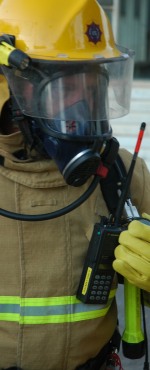
General Description
Self contained compressed air open circuit breathing apparatus. The sets have a low pressure warning whistle will activate when there is approximately 50 bar of air left.
Facemask
Polycarbonate high visibility visor with inner ori-nasal mask to prevent misting up. The mask itself is constructed from neoprene rubber or silicon and is held in place by a five point adjustable harness. All sets are required to be positive pressure to prevent an inflow of toxic gases into the facemask. Masks have a supplementary air flow button to allow extra air to be pushed onto the face if the need arises. The demand valve is activated on a first breath system which switches the sets into positive mode when the operator puts the mask on and takes a breath.
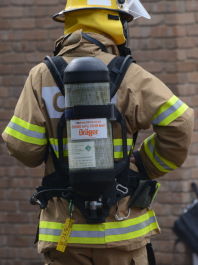
Cylinder
Each cylinder has a 9 litre water capacity charged to 300 bar or 3000 kpa. The Drager sets are capable of a single cylinder on each set. The duration of the cylinder can be calculated with the following formula: volume (in Litres) x pressure (in bars) / 40 - 10 in minutes, (the 40 is the average air consumption rate in litres for an average person to use in a minute walking at 6 km/h, and the 10 is subtracted to provide a safety margin), so the 9-litre cylinder, at 300bar, is 9 X 300 / 40 - 10 = 57.5 minutes working duration. The relative fitness, and especially the level of exertion of the wearer, often results in variations of the actual usable time that the cylinder can provide air, often reducing the working time by up to 50%.
Backplate
Previously made from stainless steel but changing now to polycarbonate heat resistant plastic. The cylinder is held on via one strap. The backplate is designed with the comfort of the wearer in mind.
Harness
Made from black nylon webbing. The waistbelt incorporates a stiffener so that it comes easily to hand when donning the set. Buckles are snap fit glass reinforced plastic. The shoulder harness is padded with loops for the air hoses.Contents Gauge
A Bourdan type gauge, this is measure in bars ( 1 bar =14.7 psi) and reads up to 250 bars (3675 psi). It is luminous and waterproof with a blow out back which will vent full cylinder pressure in the event of a failure of the pressure system.
Ancillary Items
| In addition to the set and cylinder each set must have the following items attached before entry into an incident. It should be noted that wearers will be refused entry if these any of these items are missing. |
Distress Signal Unit |
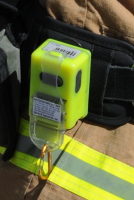 A device which signals that a firefighter is trapped and needs assistance.
Also incorporated in some models is a evacuation signal in case of possible
building collapse etc.
A device which signals that a firefighter is trapped and needs assistance.
Also incorporated in some models is a evacuation signal in case of possible
building collapse etc.The DSU is an electronic device permanently attached to each set. Before going into the incident a highly visible yellow key (attached to a tally) is removed from the device which activates the DSU. If after 30 seconds the device does not sense any movement it go into pre-alarm mode activating a alarm. If after another 10 seconds the wearer has not moved it then goes into full distress alarm. It cannot be switched off until the wearer returns outside and the key re-inserted, or a combination of buttons are pressed. This ensures that even an unconscious firefighter can issue an alert. Once a wearer activates the DSU, they begin an entrapment procedure, which involves relaxing and conserving their air to wait for rescue. |
Tally |

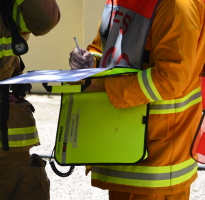
The tally is a yellow plastic strip attached to the distress signal unit key. Before entering the incident the operator hands it to the Breathing Apparatus Entry Control Officer (ECO) who puts it in the breathing apparatus control board. On the tally is the Firefighters name, time in, contents of the cylinder and station. This allows the ECO to determine when the crew should be out and who and where they are. |
Guide Lines |
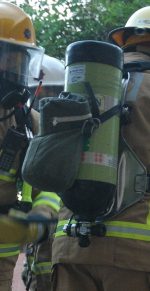
A small diameter line for the purpose of allowing subsequent BA teams to proceed directly to a fire in a smoke logged building by following the route of the line while attached to it via a snap hook. A Personal Line is housed in a small bag attached to the set and is 6 metres long, with a loop 1 metre from the start. 
Main Guide line is housed in a bag carried on the set which pays out the line as the team advances. It is 60m long with ordered metal ferrules located at 3 metre intervals. These ferrules allow the team to tell by touch if they heading to the fire or the exit. Personal lines are used to attach to this line. Guide Line Tallies are used to identify a Guide Line during an incident.
|
Torch |
|
Intrinsically safe, used to see in the dark!

|
Breathing Apparatus Procedures
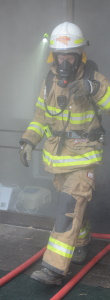
- Minimum 2 personnel on a breathing apparatus team.
- Must maintain physical contact via touch or personal line.
- Must be out before low pressure air whistle sounds
- Must deposit and collect tallies from BA Entry Control Officer (ECO)
- Must don masks in fresh air and not remove until returned outside.
- Air and time out calculated on the lowest team members cylinder contents.
- Minimum contents on entry is 80% of a full cylinder i.e. 180 bar.
- Working duration on full cylinder is 35 minutes with 10 minutes safety i.e. total 45mins.
Photographs on this page taken by Emmanuel Cusack - Littlehampton CFS & the CFS Promotions Unit







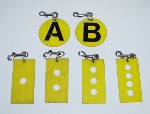 Main Guidelines are attached externally to the building, and a Main Line Tally,
lettered A or B is then attached to the start of the line. Branch Line tallies, numbered 1 to 4 are used internally and are attached to a point along the Main Guideline.
These have holes stamped in the tallies to indicate the number so they can be identified in poor visibility conditions.
Main Guidelines are attached externally to the building, and a Main Line Tally,
lettered A or B is then attached to the start of the line. Branch Line tallies, numbered 1 to 4 are used internally and are attached to a point along the Main Guideline.
These have holes stamped in the tallies to indicate the number so they can be identified in poor visibility conditions.
